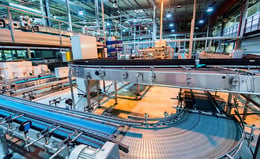How Can Manufacturers Avoid Supply Shortages?
Brian Hoey - May 05, 2020

 A few years ago, more than three-quarters of manufacturers said that material shortages (specifically metals and minerals) were a significant source of business risk within their operations. Though the global supply chain has become more connected and more technologically advanced since then, it’s also had to face a number of murky new realities with the advent of the global COVID-19 pandemic. Indeed, as with any crisis of this magnitude, we’re quickly learning where the gaps are in the global supply chain—and the ripple effects that those effects can have.
A few years ago, more than three-quarters of manufacturers said that material shortages (specifically metals and minerals) were a significant source of business risk within their operations. Though the global supply chain has become more connected and more technologically advanced since then, it’s also had to face a number of murky new realities with the advent of the global COVID-19 pandemic. Indeed, as with any crisis of this magnitude, we’re quickly learning where the gaps are in the global supply chain—and the ripple effects that those effects can have.
Whether or not any particular crisis specifically impacts the materials that your business relies upon for its production workflows, it’s always a good time to take stock of the resilience of your supply chain. After all, if a particular trade route being cut off or a particular region experiencing production shutdowns is going to wreak havoc on your production plans, it’s obviously better to figure that out ahead of time so that you can take steps to avoid that happening.
What’s Increasing Your Supply Chain Risk?
Naturally, manufacturers want to reduce supply chain risk in any way they can—whether that’s by tracking machine usage within their own factories in order to reduce unplanned downtime, or integrating with suppliers to gain advanced warning when shipments of raw materials might be late, or using data and analytics to power improved demand forecasts. When it comes to supply shortages in particular, there are a few specific risk factors that might be making a disruption more likely:
- Poor end-to-end visibility: If you can’t see what’s going on across your entire supply chain, your odds of identifying a potential disruption in advance go down precipitously. If, by contrast, you have insights into what’s happening with your suppliers and logistics partners, you’re much more likely to identify potential shortages before they become problems.
- Data silos: It might seem like data silos would be more of a planning and forecasting problem, but in point of fact you need as much data as possible to create an accurate BOM (bill of materials) for every production run. If you can’t access information about past production runs (including both the materials used and the attrition rate for those materials—i.e. how many products or materials were tossed out as defective), then you may run short of materials because you simply don’t know how much you need and in what quantities.
- Safety stock: Obviously, you want to keep the minimum viable amount of safety stock, without storing a large quantity of materials that you don’t actually need. If this stock is too low to weather a delayed order of raw materials, however, you may be incurring unnecessary risk. The trick is finding that sweet spot between unnecessary storage costs and insufficient resiliency.
Naturally, there are plenty of external factors that will impact your risk of supply shortages—but it’s the internal factors that will determine the extent to which those external factors are able to bloom into full-scale disruptions.
Advanced Analytics for Demand Capacity Planning
You might have noticed that a lot of the risk factors we outlined above revolved around having the right information. This isn’t a coincidence. On the contrary, your ability to collect, store, and analyze the information you need is going to correlate directly with your ability to stave off disruptions of all kinds. When it comes to parts outages in particular, you’ll be particularly interested in information about your suppliers and your actual production programs, plus anything that can give you a better handle on likely demand levels for individual products. Essentially, what you’re doing when you try to avoid supply shortages is a kind of demand capacity planning. As such, those two elements always need to be top of mind.
Traditionally, demand-capacity planning might have involved totting up a few estimates in a spreadsheet for upcoming demand and cross-referencing that against your production capacity estimates. In the modern, digital supply chain, however, you can get a little more sophisticated: Once you’ve collected the relevant data, you can feed that information into an advanced analytics algorithm in order to predict both your likely upcoming demand levels and your relative capacity needs with never-before-seen degrees of accuracy. These analytics workflows can give you advanced warning that you’re likely to see a spike in demand for a particular product, such that you can manage your supplier orders accordingly. By the same token, you can use these predictive and prescriptive capabilities to optimize your supply network. Are you relying too heavily on one company or one region for a particular raw material, thereby courting disruption? Analytics can help you figure that out
How S&OE Powers Intelligent Planning
Once your predictive powers have been enhanced by analytics processes, you’re already in a better position than ever to avoid supply shortfalls. But on a day-to-day basis, you might still run into volatility that challenges your planned production programs. What strategies should you use to fight off that day-to-day or week-to-week volatility? One potential option is to implement an S&OE (sales and operations execution) workflow. These kinds of workflows are designed to complement S&OP (sales and operations planning) processes that will be generating long-term plans for meeting demand based on your improved forecasts. How? By making minute adjustments to transport plans and inventory levels on a daily and weekly basis.
Not only does this ensure that longer term plans stay on track, it also helps your operation leverage flexibility when it comes to production processes. Expecting a parts shipment to be one day late? S&OE planners can adjust production ratios from one day to the next to make sure that doesn’t result in downtime. Expecting a spike in demand? Your S&OE workflow should give you the visibility to utilize your buffer stock in the most value-additive way. In this way, you’re able to create a value chain that’s truly agile—one in which you can operationalize plans successfully while efficiently managing potential disruptions. The end result is true intelligent planning that can more easily stave off supply shortages.
LATEST POSTS
- Understand Circular Economy in The Manufacturing Industry
- How Can Industry 4.0 IT Integration Be Achieved Smoothly?
- The Significance of Order Sequencing in Discrete Manufacturing
- How to improve your Supply Chain Management: The Power of Control Towers
- Optimizing Human Resource Scheduling in Manufacturing: A Technological Approach



